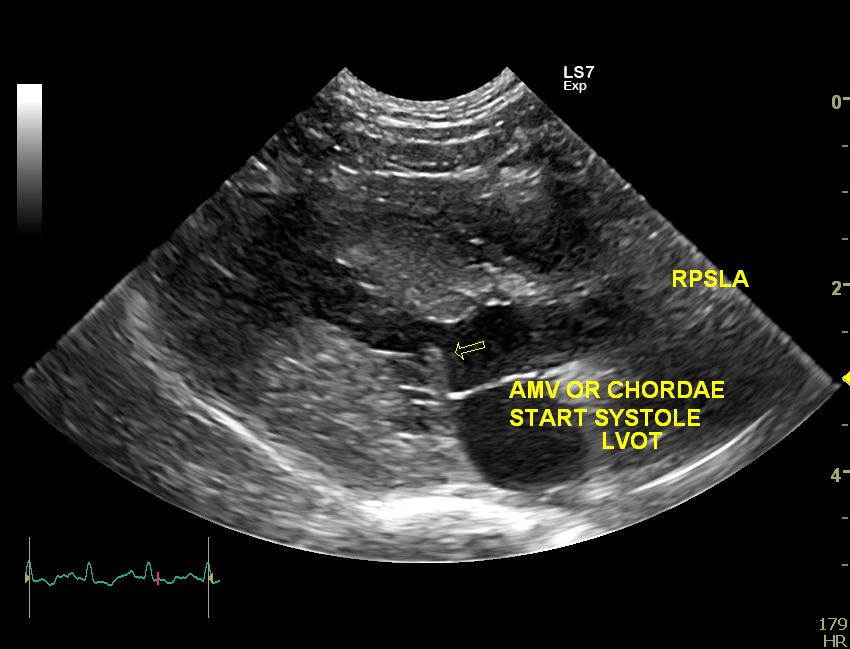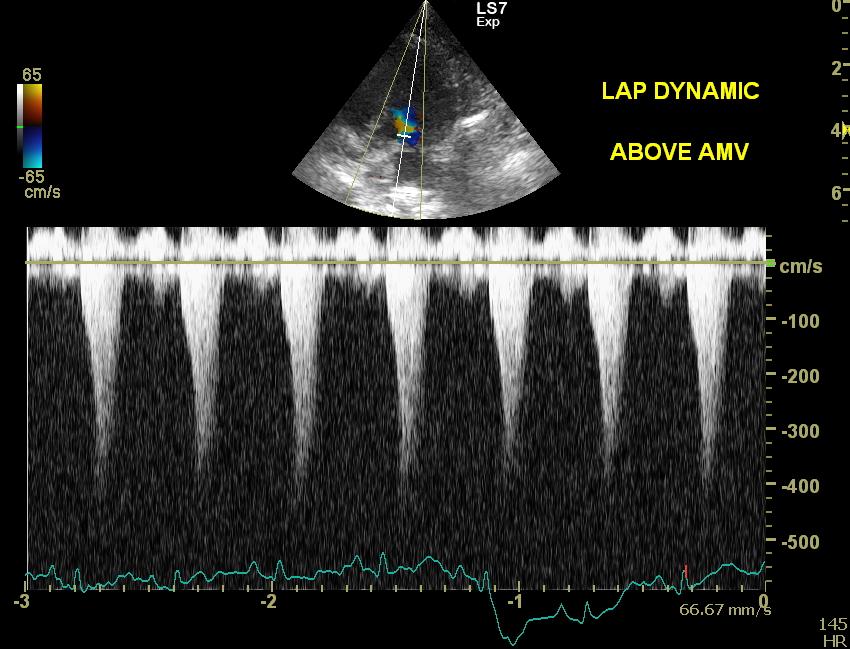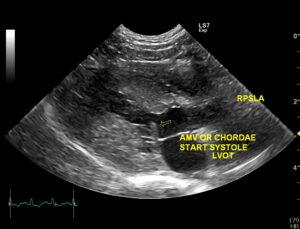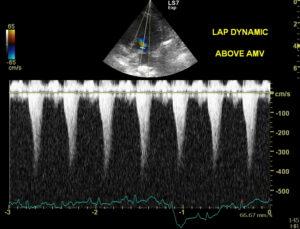History
-Clinically normal two-and-a-half-year-old male neutered DMH cat with a 3/6 murmur.
– NT pro-BNP was 1500 pmols/L.
– Feline was stressed and also sedated with midazolam and butorphanol.
Echo Findings
-Stage B1 HCM (phenotype)
-Generalized LV hypertrophy, systolic LV chamber obliteration
– Mitral SAM with eccentric jet of mitral regurgitation.
-Papillary muscles where enlarged and echogenic suggesting the possibility of early fibrosis.
-Left atrial size was just normal or equivocal to the feline cut-offs for LA size.
-When heart rate was slow enough, there was reversal of the E:A mitral inflow ratio suggesting mild diastolic dysfunction.
-The mitral regurgitant velocity ,determined best from the RPSLA view, was 6.35m/s (systolic LV pressure of at least 161.1mmHg
Q1:
-In the apical view ,at the septal base and just below, I recorded flow rates of 2.4-2.6m/s using CWD(mild gradient). Directly opposite this position, at the level of the anterior mitral valve/LVOT, CWD doppler measured a velocity closer to 4m/s with a mild dynamic component. This high-pressure area is consistent with the area of SAM in the jpegs provided as well as the nidus for mitral regurgitation( parachute effect on chordae?).
Is this a legitimate pressure gradient generated by the obstruction just above the AMV or am I just picking up some MV regurgitation at that same level?
Q2:
An NT pro-BNP of 1500 pmols/L obviously suggests a significant cardiac component with this case. Cats with HCM and SAM, without LA enlargement can have a median NT pro-BNP level of around 750picomols/L compared to HCM cats with just LV hypertrophy, no SAM and no LA enlargement(significantly lower values).
Is there any available literature suggesting the NT pro BNP levels generated by renal, systemic hypertension, hyperthyroidism and pulmonary hypertension(not common in cats) with and without HCM or an HCM phenotype? Similarly, for dogs with some of these conditions with and without a heart component? In the literature I always see other causes for increased NT pro BNP but I can never find any values for consideration.
Thanks





3 responses to “Feline HCM”
Tough to say exactly on Q1 as your sector is covering both mr and lvot so if you cone that down just to 1 or the other this will help differentiate.
Re Q2: I see if Peter can chime in here but we went over this in the sonopath summit last month and its known and assumed that HT4, HT, infectious and essentially any systemic disease can be a cause of bnp elevation.
Regardless I agree wiht you on the no SAM and normal LA so I think this hcm phenotype case is stable as is if no ex intolerance and if resting hr is under 200, i wouldnt treat with anything right now.
HI! With your CW you’re hitting the basal septum where the outflow tract obstruction is located. Since this exactly the point where the MI starts you cannot really differentiate those. However, since you are more in alignment with the outflow tract obstruction (MI goes to the right on your recording), and there’s a dynamic (dagger shaped) profile, the max comes from the outflow tract obstruction. Btw: Sometimes it’s difficult to pick up the vmax of the DLVOTO because it changes it’s direction due to the dynamic nature
Re Q2
Plasma concentrations of natriuretic peptides in normal cats and normotensive and hypertensive cats with chronic kidney disease
Author links open overlay panelStephanie M. Lalor BVetMed, MRCVS, David J. Connolly BVetMed, Ph.D., MRCVS, Jonath, an Elliott M.A., VetMB, Ph.D., Harriet M. Syme BVetMed, Ph.D., MRCVS J Vet Cardiol 2009
Multi-centered investigation of a point-of-care NT-proBNP ELISA assay to detect moderate to severe occult (pre-clinical) feline heart disease in cats referred for cardiac evaluation☆
Maggie C. Machen DVM a, Mark A. Oyama DVM a, Sonya G. Gordon DVM, DVSc b, John E. Rush DVM, MS c, Sarah E. Achen DVM d, Rebecca L. Stepien DVM e, Philip R. Fox DVM f, Ashley B. Saunders DVM b, Suzanne M. Cunningham DVM c, Pamela M. Lee DVM f, Heidi B. Kellihan DVM
Cardiac Biomarkers in Hyperthyroid Cats
Cardiac Biomarkers in Hyperthyroid Cats
J.K. Sangster, 1 D.L. Panciera,corresponding author 1 J.A. Abbott, 1 K.C. Zimmerman, 2 and A.C. Lantis 1 , 3, JVIM, 2014
Thank you both. I was fishing around with the CWD to get a maximum which was at the level in the jpeg. The velocity at the septal base was lower so I was assuming it could be MR not aligned well( highest MR I could get was from the RPSLA view because of its arcing nature on the Apical view) in this maximum area. That area coincided with the obstruction occurring in the RPSLA view? On his recheck, I’ll fish around and see if I can get more confident results.
Thank you for the literature too!
Dan